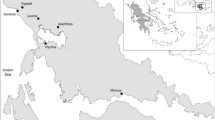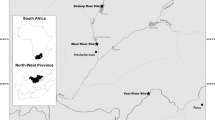Abstract
Precise identification of members of the genusDiplostomum is difficult in that many larval stages have been described and named separately from their adult forms. In this study, the life cycles of twoDiplostomum spp. were established using metacercariae obtained from the eyes of rainbow trout. The parasites were identified asD. spathaceum andD. pseudobaeri using a procedure and key devised by Shigin. Each life cycle was completed in the laboratory using domestic chickens (Gallus gallus domesticus L.) as definitive hosts andLymnaea peregra (Muller) and rainbow trout as first and second intermediate hosts, respectively. Utilizing identical hosts minimised host-induced morphological variations and allowed comparisons of anatomical features to be made. Light and scanning electron microscopy were used to study each developmental stage and detailed descriptions of the life cycles were compiled. The results obtained may go some way to resolving the confusion that surroundsDiplostomum taxonomy.
Similar content being viewed by others
References
Bell EJ, Smyth JD (1958) Cytological and histochemical criteria for evaluating development of trematodes and pseudophyllidean cestodes in vivo and in vitro. Parasitology 48:131–148
Berrie AD (1960) The influence of various definitive hosts on the development ofDiplostomum phoxini (Strigeidae, Trematoda). J Helminthol 34:205–210
Betterton C (1974) Studies on the host specificity of eye fluke,Diplostomum spathaceum, in brown and rainbow trout. Parasitology 69:11–29
Bortz BM, Kenny GE, Pauley GB, Milan-Bunt BH (1988) Prevalence of two site specific populations ofDiplostomum spp. in eye infections of rainbow trout (Salmo gairdneri Richardson) from lakes in Washington State, USA. J Fish Biol 33:31–43
Chubb JC (1979) Seasonal occurrences of helminths in freshwater fishes. II. Trematoda. Adv Parasitol 17:141–313
Cichowlas Z (1961) The life cycle ofDiplostomum spathaceum (Rud. 1819) in brackish waters of the Baltic Sea. Acta Parasitol Pol 9:33–46
Dick TA, Rosen R (1981) Identification ofDiplostomum spp. from the eyes of white fish,Coregonus clupeaforms (Mitchell), based on experimental infections of herring gull chicks,Larus argentatus (Pontoppidan). Can J Zool 59:1176–1179
Dubois G (1970) Synopsis des Strigeidae et des Diplostomatidae (Trematoda). Mem Soc Neuchatel Sci Nat 10:288–376
Field JS, Irwin SWB (1994) The epidemiology, treatment and control of diplostomiasis on a fish farm in Northern Ireland. In: Pike AW, Lewis JW (eds) Parasitic diseases of fish. Samara Publishing Limited. Dyfed, pp 87–100
Field JS, McKeown CA, Irwin SWB (1994) A proposed standard method for the maintenance ofDiplostomum spp. (Digenea: Diplostomatidae) in the laboratory. Parasitol Res 80:253–254
Gaten E (1987) Aggregation of the eyeflukeDiplostomum spathaceum (Digenea: Diplostomatidae) in the lenses of various species of fish. J Fish Dis 10:69–74
Gibson DI (1987) Questions in digenean systematics and evolution. Parasitology 95:429–460
Grazyk T (1991) Variability of metacercariae ofDiplostomum spathaceum (Rudolphi, 1819) (Trematoda, Diplostomidae). Acta Parasitol Pol 36:135–139
Höglund J (1990) Thermal effects on parasitic eyeflukes in fish — a case study (dissertation, Faculty of Science, University of Uppsala). Diss Abstr Int 53/02-C:265–302
Hoffmann GL (1967) Parasites of American freshwater fishes. University of California Press, Berkeley Los Angeles
Hoffmann GL, Hundley JB (1957) The life cycle ofDiplostomum baeri eucaliae n. subsp. (Trematoda: Strigeidae). J Parasitol 43:613–627
Hugh RC, Berkout PG (1929) Studies on the trematode family Strigeidae (Holostomidae). XV.Diplostomum gigas sp. nov. Pap Mich Acad Sci Arts Lett 9:483–488
Irwin SWB, Saville DH (1988) An alternative method for the cultivation ofDiplostomum spathaceum (Trematoda) in chick embryos. J Parasitol 74:504–505
Kalfa-Papaioannou AM, Sinis AI (1985) Metacercairae ofDiplostomum spathaceum in freshwater fish of the lake system Koronia and Vovi (Macedonia, Greece). Zentralbl Veterinarmed [B] 32:65–70
Kannangara DWW, Smyth JD (1974) In vitro cultivation ofDiplostomum spathaceum andDiplostomum phoxini metacercariac. Int J Parasitol 4:667–673
Leno GH, Halloway HL Jr (1986) The culture ofDiplostomum spathaceum on the chick chorioallantois. J Parasitol 72:555–558
Lester RJ, Huizinga HW (1977)Diplostomum adamsi sp. n.: decription, life cycle, and pathogenesis in the retina ofPerca flavescens. Can J Zool 55:64–73
McCloughlin TJJ, Irwin SWB (1991) The occurrence of eye flukes in fish from the Erne catchment area. Irish Nat J 23:409–414
McDonald ME (1981) Key to trematodes reported in waterfowl. U S Fish Wildl Sery Resource Publ 142:41–42
McKeown CA (1992) Investigation of parasitism byDiplostomum spp. in the wild fish population in the lower Bann. PhD Thesis, University of Ulster
Niewiadomska K (1970) An analysis of criteria for genetic differentiation within the order Strigeidida (La Rue 1926). Acta Parasitol Pol 18:277–289
Niewiadomska K (1986) Verification of the life cycles ofDiplostomum spathaceum (Rudolphi, 1819) and differentiation ofDiplostomum pseudospathaceum nom. nov. (Trematoda: Diplostomidae). Syst Parasitol 6:81–86
Niewiadomska K (1987)Diplostomum paracaudum (Iles 1959), Shigin 1977 (Digenea, Diplostomidae) and its larval stages: a new record from Poland. Acta Parasitol Pol 31:199–210
Niewiadomska K (1988)Diplostomum metacercariae (Digenea) in the fish of the Olga, Wielki and Warniak lakes:D. numericum sp. n. andD. baeri Dubois 1937, with comments on the synonymy of this species. Acta Parasitol Pol 33:7–24
Niewiadomska K, Nasincová V (1990) Scanning electron microscope verification of armature and chaetotaxy ofDiplostomum paracaudum (Iles, 1959) cercariae (Digenea: Diplostimatidae). Ann Parasitol Hum Comp 65:67–73
Palmer ED (1939) Diplostomiasis, a hatchery disease of freshwater fishes new to North America. Prog Fish Cult 45:41–47
Rees G (1955) The adult and diplostomulum stage [Diplostomum phoxini (Faust)] ofDiplostomum pelmatoides Dubois and an experimental demonstration of part of the life cycle. Parasitology 45:295–312
Richard J (1971) La chaétotaxie des cercaires. Valeur systématique et phylétique. Mem Mus Nat Hist Nat [A] 67:1–179
Sato T, Hoshina I, Horiuchi M (1975) On worm cataracts of rainbow trout in Japan. Bull Jpn Soc Sci Fish 42:249
Shigin AA (1976) Metacercariae of the genusDiplostomum in the fauna of the USSR (in Russian). Parasitologiya 10:346–351
Shigin AA (1986) Trematode fauna of the USSR genusDiplostomum metacercariae (transl by Chubb JC, University of Liverpool). Isocitel, Stvo Nauka, Moscow
Skrjabin KI (1960) Trematodes of animal and man. (Essentials in trematology, vol 17; English transl 1964) Israel Programme for Scientific Translation, Jerusalem
Skrjabin KI (1971) Trematodes of animal and man. (Fundamentals of trematology, vol 24) Ameriad, New Delhi Bombay Calcutta New York, pp 160–276
Sweeting RA (1974) Investigation into experimental and natural infections of freshwater fish by the common eye flukeDiplostomum spathaceum Rud. Parasitology 69:291–300
Williams MO (1966) Studies on the morphology and life cycle ofDiplostomum (Diplostomulum) gasterostei (Strigeida: Trematoda). Parasitology 56:693–706
Author information
Authors and Affiliations
Rights and permissions
About this article
Cite this article
Field, J.S., Irwin, S.W.B. Life-cycle description and comparison ofDiplostomum spathaceum (Rudolphi, 1819) andD. pseudobaeri (Razmaskin & Andrejak, 1978) from rainbow trout (Oncorhynchus mykiss Walbaum) maintained in identical hosts. Parasitol Res 81, 505–517 (1995). https://doi.org/10.1007/BF00931794
Received:
Accepted:
Issue Date:
DOI: https://doi.org/10.1007/BF00931794




